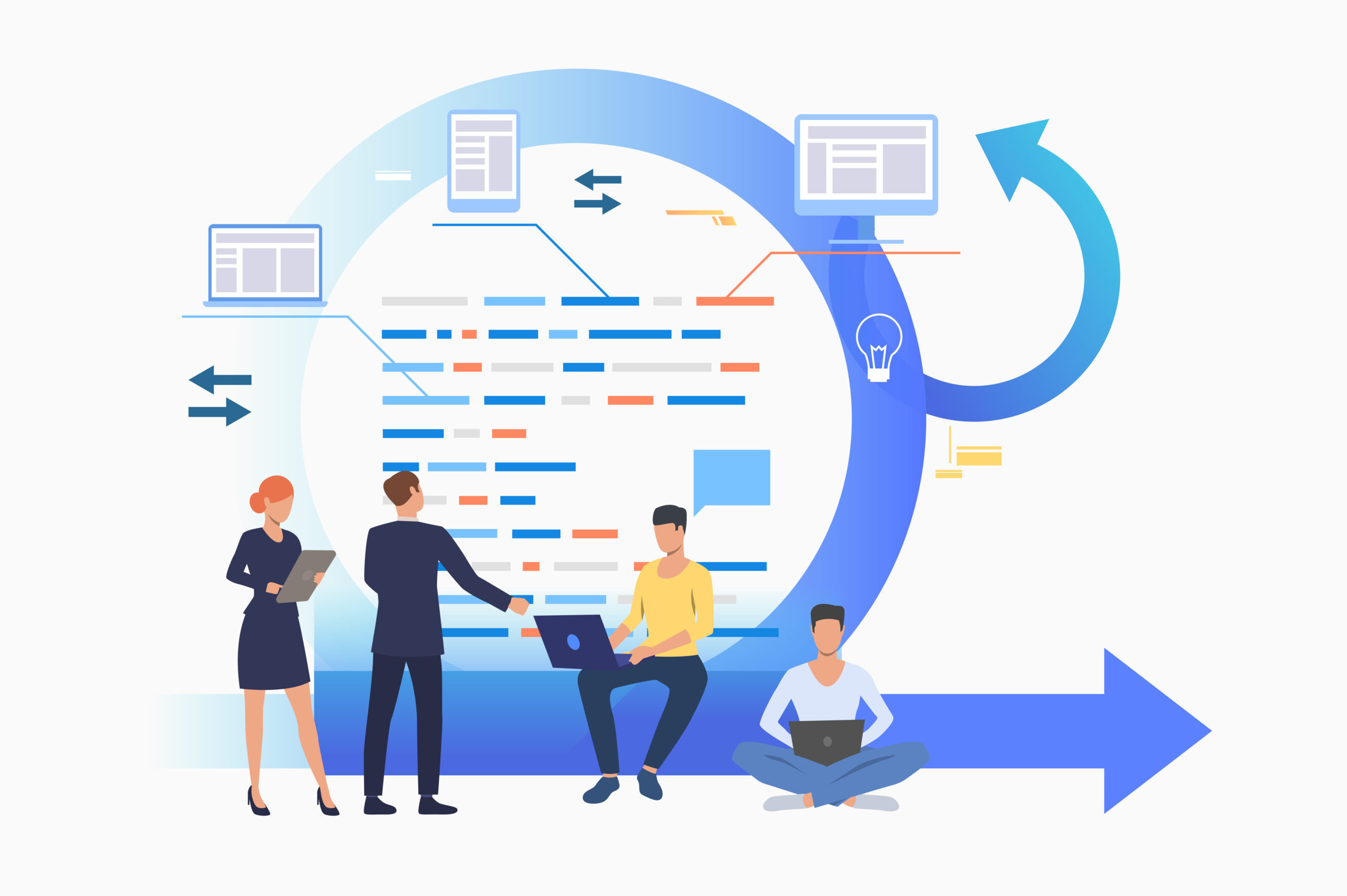
Scrum and Scaled Agile Framework (SAFe): Collaborative ways of working
Scrum and Scaled Agile Framework (SAFe): Collaborative ways of working
It was in the spring of 2000 that a group of 17 developers introduced agile to ensure Faster Time-to-market with a quick collection of feedback and continuous improvement. However, it gained popularity in the IT and product development industry over the last ten years. While there are approximately 50+ Agile methodologies with each unique mix of characteristics, practices, terminology, and tactics, we have seen Scrum and SAFe as being widely adopted across the industry. Once you know more about how either of the methods is unique, from an implementation standpoint, you will be able to choose the best framework that suits your business precisely and perfectly.
What is Agile?
Agile is a mindset. It tells you how to do things. It is the Manifesto (way of doing things), which provides users with the principles, values, and approaches to ensure higher customer satisfaction, speed, efficiency, higher quality, and overall ROI. Agile practices are a set of behaviors and techniques that uses an experiential approach to deliver as much business value as possible in a given amount of time. Such practices follow inspect-and-adapt points to accommodate emerging requirements. As IT organizations go through transition and face ever-evolving and changing customer demands, they practice agile methodology to attain customer satisfaction.
According to a recent study by Gartner, 87% of IT professionals use Agile for at least some of their Application Development.
Agile Methodologies and Frameworks:
Several methodologies are using an agile mindset. While implementing Agile, it is not imperative to use any particular approach, but one can choose the best practices from various agile methodologies and implement them.
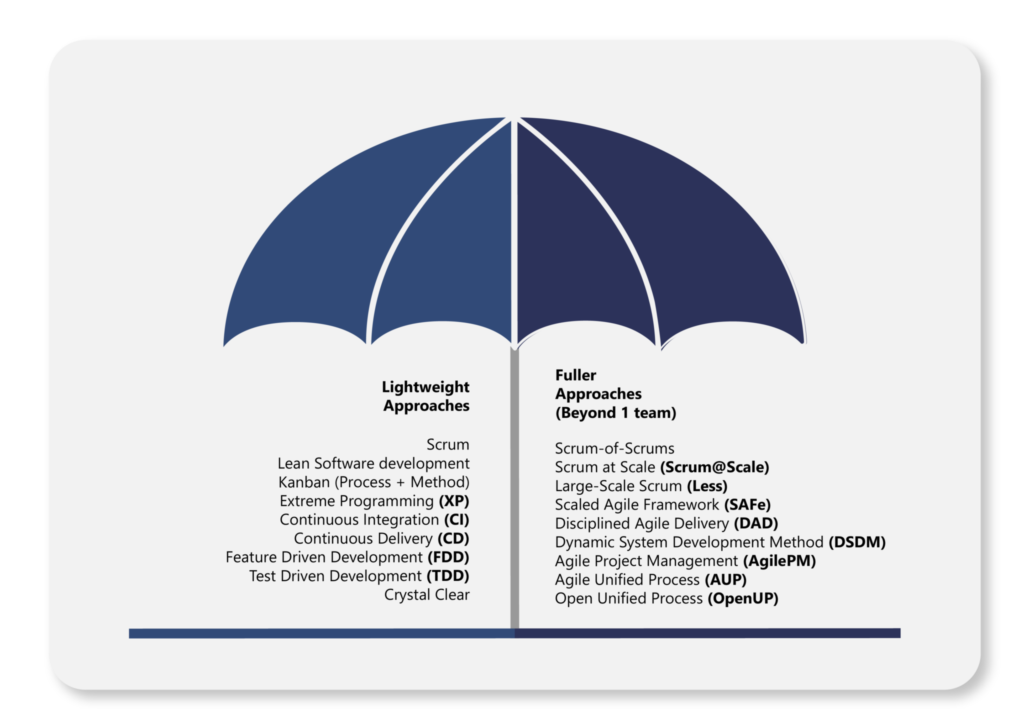
Let’s get some more insights on the two most widely used Agile methodologies in the world, i.e., Scrum and SAFe.
What is Scrum?
Consider Agile as a family of which Scrum is a member; therefore, scrum is a type of agile practice. It is similar to thinking of a family called ‘vegetable’ where the carrot is a member, and so is broccoli. Scrum also uses iterations, called sprints, and includes critical inspect-and-adapt points, which involve sprint planning, daily Scrum, sprint review, sprint retrospective.
Scrum is among the most popular of all agile methodologies and therefore has become a sort of de facto standard in many software development organizations. It is an iterative method of product development that focuses on a cross-functional team working with clearly defined and specific supporting roles, regular delivery of tasks or chunks of work, and a set of protocols and formalities that can help in steer the product development. Therefore, scrum is a lightweight, agile framework, under which people or members associated within the product development umbrella can address their complex adaptive problems, and at the same time, deliver products of the highest possible value productively. Responsibilities in Scrum are roughly divided as follows:
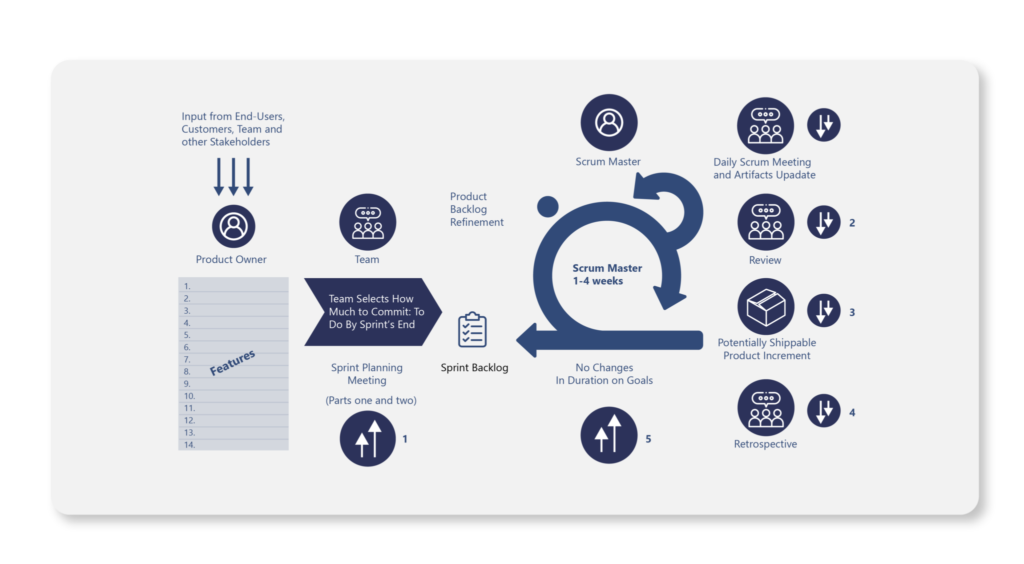
Scrum Framework
Scrum methodology intends to break the system/application into smaller iterating incremental builds with each iteration typically lasting from about one to four weeks called a sprint.
Each sprint is like a mini software development life cycle. These Agile mini sprints follow a pattern similar for the analysis, development, implementation, testing, and evaluation process. Unit and integration testing is performed at the end of each development sprint. Any issues/ obstacles/ impediments raised by the Testing Specialists can be addressed during the Sprint Retrospective meetings for effective planning of the following sprint. Each iteration of development, product demo, and feedback gathering session with the client marks the end of the respective sprint followed by deciding steps for goal setting and requirements definition of the next sprint. The process repeats itself until the final application is moved into production.
While the sprints keep development on track as per the predefined timeline, they also allow for progress updates and checkpoints to determine that the project requirements are being met. It helps to ensure that the final product is launched on time and fits the needs of the business defined during the initial phases of the project envisioning.
What is SAFe?
Scaled Agile Framework (SAFe) helps large organizations with complex structures in scaling Agile practices. It integrates the latest thinking from Lean, Agile, and DevOps into a set of principles and procedures that transform the culture and behavior of an entire enterprise.
Based in South Africa, Standard Bank embarks on approximately 600 projects every year to help keep the bank at the leading edge. Traditionally, its IT teams have completed only a small percentage of projects within the defined timeframe, budget, and scope. SAFe accelerated Standard Banks’s Time-to-market by 23 times to which Alex Keyter, Lean-Agile Transformation Consultant (SPC4), says, “SAFe provided the structure we needed to scale Agile enterprise-wide. It addressed the complexities and gave us the framework for building portfolios, roles, and jobs to achieve our goals for productivity, morale, and quality.”
SAFe is a venture scale development structure that utilizes a mix of existing lean and agile principles and consolidates them into a templated system for large-scale projects. It guides teams on how to handle a situation. SAFe works under four levels. The topmost level is the portfolio, followed by an optional value stream level for large enterprises, followed by program level, and team level.
If we draw a parallel of SAFe with scrum, the team level in SAFe is similar to scrum, where the focus is on the project. The program level in SAFe discusses how to get all the projects to plan for one program increment release in the agile release train. It also discusses plans to conduct product level demos about the roles required for coordination and leadership.
Benefits of SAFe
- Allow individual team(s) to use agile in multiple groups at an enterprise level
- SAFe drives faster time to market
- Increase in productivity and quality
- Higher customer engagement
- Involves upper management, and combines planning with the enterprise’s strategies
- Ensures each team is aligned with the company’s vision, mission and goal
SAFe Framework
SAFe provides guidance on the seven core competencies which help organizations become Lean Enterprise and achieve Business agility and customer-centricity. Cisco adopted the below SAFe framework for its Subscription billing platform to realize a 40% defect reduction. Cisco created three ARTs* (Agile Release Trains) for Capabilities, Defects/fixes, and Projects working towards a common goal.
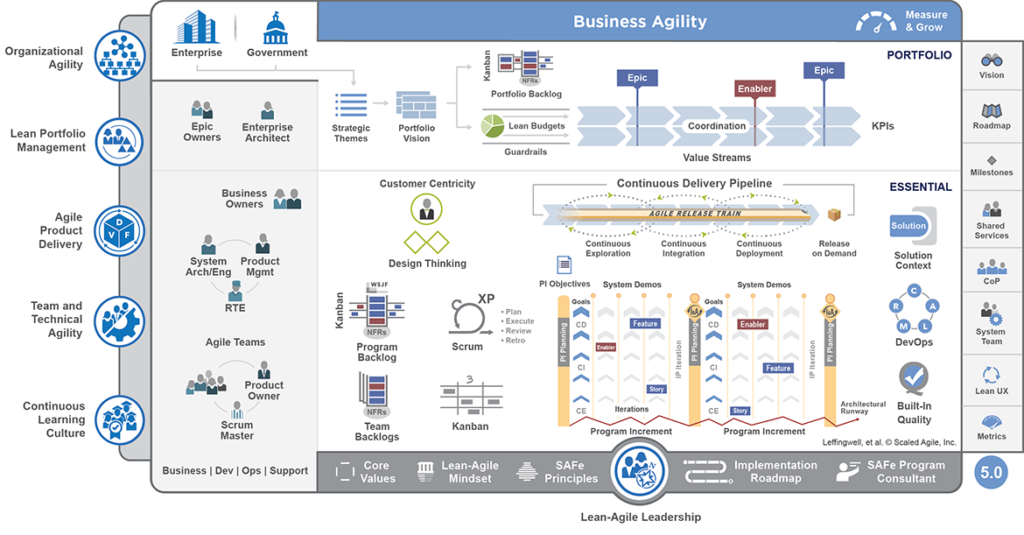
Scrum vs. SAFe
Scrum is a team level framework, and SAFe ®️ is an enterprise-level establishment method.
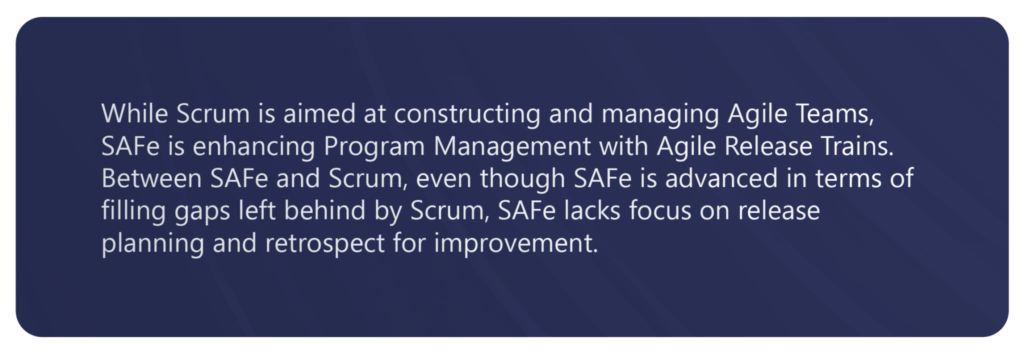
The significant difference between the two depends on the way they choose to handle their work. To understand in simple words, Scrum is used to organize small teams, while SAFe®️ is used for multiple teams. Moreover, while practicing agile methodologies, there are chances to miss important aspects that SAFe®️ manages to contain. The table below sheds some light on a few more dissimilarities between Scrum and SAFe.
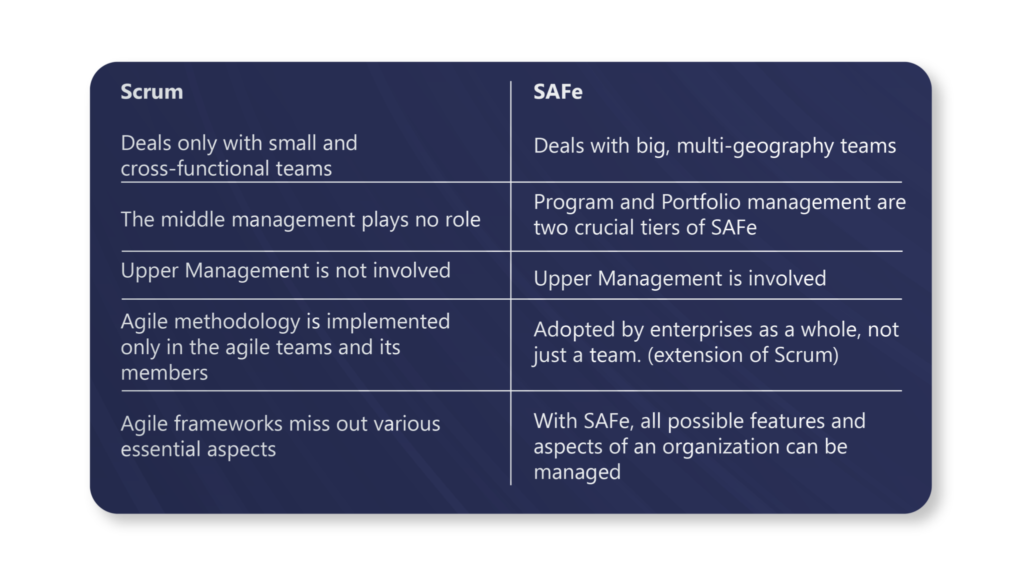
Conclusion
To conclude, we must understand our organization’s needs. If you want to use Agile, but you work in a large organization that deals with large scale and mission-critical projects, it is suggested to use SAFe, which would serve you better than other less-focused agile frameworks, for that matter, scrum agile.
While we do not prefer one framework over another; instead, we develop custom-tailored Agile frameworks with best practices from various frameworks, considering elements that are in line with your business needs, such as:
- What is the objective of implementing a methodology in your organization?
- What is the level of involvement of management within the project?
- What is the size of your organization?
- What is your organizational structure?
- The type of projects your company deals with and manages?
- What are the stakeholders’ requirements and their opinions?
Reach out to Bids and Beyond if you need help developing the right Agile Frameworks for your customers and sweep them off their feet with the right pitch.
tx, USA

London, UK

India

